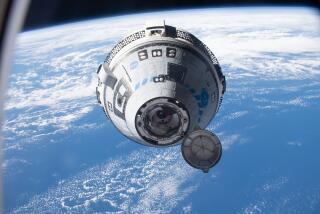F-35 fighter jet conducts first in-flight missile launch near L.A.
- Share via
An F-35 fighter jet launched a missile in mid-flight from its internal weapons bay for the first time in a test flight for the Air Force.
The missile firing took place last week about 60 miles northwest of Los Angeles at the Navy’s Point Mugu Sea Test Range after the plane took off from Edwards Air Force Base. It is a milestone that paves the way for targeted launches later this year.
On Monday, aircraft manufacturer Lockheed Martin Corp. released a video in which the F-35 ejects an AIM-120 missile that briefly falls before firing its rocket motor and bursting into flight.
“It’s a testament to the entire military-industry test team,” said the pilot, Lt. Col. George “Boxer” Schwartz. “They’ve worked thousands and thousands of hours to get to this point -- to where we are today.”
Indeed. The F-35 is a nearly $400-billion weapons program under development for more than a decade.
There are three versions of the F-35 being developed for the Pentagon.
Called the Joint Strike Fighter program, it is centered around a plan to develop one basic fighter plane that could -- with a few tweaks -- be used on runways and aircraft carriers, and hover like a helicopter for joint use by the Air Force, Navy and Marine Corps.
If the plane is successful, it will be the first time that a fighter jet will have supersonic speed, radar-evading stealth and short takeoff/vertical landing capabilities.
The Pentagon’s long-term vision is to replace today’s aging fighter fleets with 2,457 F-35s.
The Marine version is expected to be the first of the three versions to go into service. It’s scheduled to be delivered in 2015. The Air Force would be second to get operational F-35s when its version goes into service in 2016.
The Air Force’s plane is designed to carry a payload of up to 18,000 pounds using 10 weapon stations. It features four internal weapon stations in two weapon bays to maximize stealth capability.
The F-35 program is billions of dollars over budget and years behind schedule. The per-plane cost estimates have gone from $81 million in 2001 to $161 million today, according to the Government Accountability Office.
But Lockheed has promoted the fact that the F-35 provides 127,000 direct and indirect jobs in 47 states and Puerto Rico. The company expects to pump an estimated $6 billion into California’s economy and create 27,000 jobs.
ALSO:
How I Made It: SpaceX exec Gwynne Shotwell
Boeing shifting 300 engineering jobs to Long Beach
Pair of aviation buffs sifts through Mojave for aerospace ruins
More to Read
Inside the business of entertainment
The Wide Shot brings you news, analysis and insights on everything from streaming wars to production — and what it all means for the future.
You may occasionally receive promotional content from the Los Angeles Times.











